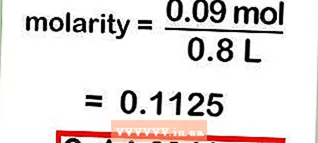Author:
Carl Weaver
Date Of Creation:
22 February 2021
Update Date:
1 July 2024

Content
- Steps
- Method 1 of 2: Calculate the molar absorption coefficient using the formula
- Method 2 of 2: Graphical Finding of the Molar Absorption Coefficient
- Additional articles
The molar absorption coefficient, also known as the molar extinction coefficient, is a measure of how strongly chemical particles (molecules) of a substance absorb light at a specific wavelength. Each substance is characterized by its own molar absorption coefficient, which is independent of concentration and volume. This characteristic is widely used in chemistry and should not be confused with the extinction coefficient, which is more commonly used in physics. The standard unit of measure for molar absorbance is liter divided by mole and per centimeter (L mol cm).
Steps
Method 1 of 2: Calculate the molar absorption coefficient using the formula
 1 Check out the Bouguer-Lambert-Beer law:A = ɛlc... The absorption of light in a medium is described by the equation A = ɛlc, where A - the amount of light of a certain wavelength that was absorbed by the sample, ɛ - molar absorption coefficient, l is the distance traveled by light in solution, and c - the concentration of the solution (the number of studied molecules per unit volume).
1 Check out the Bouguer-Lambert-Beer law:A = ɛlc... The absorption of light in a medium is described by the equation A = ɛlc, where A - the amount of light of a certain wavelength that was absorbed by the sample, ɛ - molar absorption coefficient, l is the distance traveled by light in solution, and c - the concentration of the solution (the number of studied molecules per unit volume). - The absorption coefficient can also be found from the ratio between the intensities of the light transmitted through the standard and the sample under study. In this case, the equation is as follows: A = log10(Io/ I).
- The light intensity is determined using a spectrophotometer.
- The absorption capacity of a solution depends on the wavelength of the light passing through it. At certain values of the wavelength, light is absorbed more strongly than at others, and these values depend on the composition of the solution. When calculating, do not forget to indicate for what wavelength they are made.
 2 Convert the Bouguer-Lambert-Beer law to express the molar absorption coefficient. Divide both sides of the equation by length and concentration, and the result is an expression for the molar absorption coefficient: ɛ = A / lc... Using this formula, you can calculate the molar absorption coefficient for a specific wavelength.
2 Convert the Bouguer-Lambert-Beer law to express the molar absorption coefficient. Divide both sides of the equation by length and concentration, and the result is an expression for the molar absorption coefficient: ɛ = A / lc... Using this formula, you can calculate the molar absorption coefficient for a specific wavelength. - The absorption capacity at a fixed distance depends on the concentration of the solution and the shape of the container used. The molar absorption coefficient eliminates these factors.
 3 Measure the required values using spectrophotometry. In a spectrophotometer, light with a specific wavelength is passed through a substance, and the intensity of the transmitted light is measured at the output. Part of the light is absorbed by the solution and the light intensity decreases. The spectrophotometer measures the intensity of the transmitted light, which is used to calculate the molar absorption coefficient.
3 Measure the required values using spectrophotometry. In a spectrophotometer, light with a specific wavelength is passed through a substance, and the intensity of the transmitted light is measured at the output. Part of the light is absorbed by the solution and the light intensity decreases. The spectrophotometer measures the intensity of the transmitted light, which is used to calculate the molar absorption coefficient. - Prepare a solution of known concentration for analysis c... Determine the concentration in units of mol / gram or mol / liter.
- For determining l measure the length of the cuvette used. Write down the length in centimeters.
- Measure the absorbance with a spectrophotometer A for a specific wavelength. Wavelength is measured in meters, but light is so short that it is usually expressed in nanometers (nm). The absorption capacity is dimensionless.
 4 Plug in the numbers and find the molar absorption coefficient. Take numerical values A, c and l and plug them into the formula ɛ = A / lc... Multiply l on the cand then divide A by this amount to find the molar absorption coefficient.
4 Plug in the numbers and find the molar absorption coefficient. Take numerical values A, c and l and plug them into the formula ɛ = A / lc... Multiply l on the cand then divide A by this amount to find the molar absorption coefficient. - Suppose you measured the absorbance of a 0.05 mol / liter solution using a 1 cm cuvette. In this case, the absorbance was 1.5 for light with a wavelength of 280 nm. How to find the molar absorption coefficient for a given solution?
- ɛ280 = A / lc = 1.5 / (1 x 0.05) = 30 L mol cm
- Suppose you measured the absorbance of a 0.05 mol / liter solution using a 1 cm cuvette. In this case, the absorbance was 1.5 for light with a wavelength of 280 nm. How to find the molar absorption coefficient for a given solution?
Method 2 of 2: Graphical Finding of the Molar Absorption Coefficient
 1 Measure the intensity of the transmitted light for different concentrations of the solution. Prepare 3-4 solutions with different concentrations.Using a spectrophotometer, measure the absorbance of solutions of different concentrations for a given wavelength. You can start with the lowest concentration solution. The order is not important, the main thing is not to confuse and record the measured absorbance values in accordance with the concentrations.
1 Measure the intensity of the transmitted light for different concentrations of the solution. Prepare 3-4 solutions with different concentrations.Using a spectrophotometer, measure the absorbance of solutions of different concentrations for a given wavelength. You can start with the lowest concentration solution. The order is not important, the main thing is not to confuse and record the measured absorbance values in accordance with the concentrations.  2 Plot the obtained values on the graph. Plot concentration on the horizontal X-axis and absorbance on the vertical Y-axis, and plot the measurements as dots.
2 Plot the obtained values on the graph. Plot concentration on the horizontal X-axis and absorbance on the vertical Y-axis, and plot the measurements as dots. - Draw a line between the points. If the measurements were performed correctly, the points should lie on a straight line, since, according to the Bouguer-Lambert-Beer law, the absorption capacity is directly proportional to the concentration.
 3 Define slope straightpassing through the experimental points. To find the slope of a line, divide the Y increment by the X abscissa increment. Take two points on the line, subtract the corresponding coordinates of one point from the coordinates of the other, and divide the Y difference by the X difference.
3 Define slope straightpassing through the experimental points. To find the slope of a line, divide the Y increment by the X abscissa increment. Take two points on the line, subtract the corresponding coordinates of one point from the coordinates of the other, and divide the Y difference by the X difference. - The slope of a straight line (the slope, or the tangent of the slope) is found as follows: (Y2 - Y1) / (X2 - X1). In this case, the point located higher along the straight line is assigned the index 2, and the lower point - the index 1.
- Suppose, at a molar concentration of 0.2, the absorbance was 0.27, and at a concentration of 0.3, it was 0.41. Absorbance is plotted on the Y-axis and concentration is plotted on the X-axis.Using the above equation, find the slope of a straight line: (Y2 - Y1) / (X2 - X1) = (0,41-0,27)/(0,3-0,2) = 0,14/0,1 = 1,4.
 4 To find the molar absorption coefficient, divide the slope of a straight line by the path traveled by the light (depth of the cuvette). The path traveled by the light equals the depth of the cuvette used in the spectrophotometer.
4 To find the molar absorption coefficient, divide the slope of a straight line by the path traveled by the light (depth of the cuvette). The path traveled by the light equals the depth of the cuvette used in the spectrophotometer. - For our example, we get: if the slope is 1.4, and the depth of the cuvette is 0.5 centimeters, then the molar absorption coefficient is 1.4 / 0.5 = 2.8 L mol cm.
Additional articles
 How to calculate square meters
How to calculate square meters  How to find the number of protons, neutrons and electrons
How to find the number of protons, neutrons and electrons  How to determine valence electrons
How to determine valence electrons  How to balance chemical equations
How to balance chemical equations  How to write the electronic configuration of an atom of any element
How to write the electronic configuration of an atom of any element  How to calculate the concentration of a solution
How to calculate the concentration of a solution  How to calculate the molarity of a solution
How to calculate the molarity of a solution  How to find the number of neutrons in an atom
How to find the number of neutrons in an atom  How to make drinking water from salt
How to make drinking water from salt  How to use the periodic table
How to use the periodic table  How to store dry ice
How to store dry ice  How to make dry ice
How to make dry ice  How to make elephant toothpaste
How to make elephant toothpaste  How to dilute the solution
How to dilute the solution



